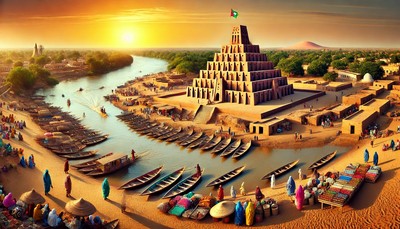Mali
TOUR IN
$4200
per person
Availability: 10 places
This Tour Has Been Planned But Dates Are Not Yet Definite And Due To Remote Location. Itinerary Is Subject To Change . The Itinerary Can Also Be Personalized And Tailored To A Small Group. DO NOT BOOK NOW .CONTACT US DIRECTLY travel@
Traveling in Mali requires careful planning due to its vast landscapes, limited infrastructure, and varying road conditions. Here’s a general guide to navigating the country:
1. Arriving in Mali
- By Air: The main international gateway is Modibo Keita International Airport (BKO) in Bamako, which connects to major African and European cities.
- By Land: Mali shares borders with several countries, including Senegal, Côte d'Ivoire, Burkina Faso, and Niger. Border crossings can be long and require proper documentation.
2. Getting Around Mali
-
By Road: The main highways connect major cities like Bamako, Ségou, Mopti, and Timbuktu, but road conditions vary.
- Public Buses: Companies like Bittar Transport and Africa Tours Trans operate between cities.
- Bush Taxis (Sotrama): Shared minibuses or taxis are common but can be crowded and slow.
- Car Rental: Available in Bamako, but self-driving is challenging due to poor road conditions and security concerns.
-
By River: The Niger River is a major transportation route.
- Pinasses (wooden boats) operate between Mopti, Djenné, and Timbuktu, offering scenic but slow travel.
- Ferries are available for longer routes, especially during the rainy season when river levels are high.
-
By Air (Domestic): Limited flights connect Bamako with regional hubs like Timbuktu, Mopti, and Gao. Charter flights may be an option for remote areas.
3. Key Routes
- Bamako → Ségou (240 km): A well-paved road leads northeast to Ségou, a former colonial town along the Niger River.
- Ségou → Mopti (400 km): A good but occasionally bumpy road connects Ségou to Mopti, a gateway to Dogon Country.
- Mopti → Djenné (130 km): Requires crossing a river ferry to reach Djenné’s famous mud mosque.
- Mopti → Timbuktu:
- By road: Long and challenging due to desert conditions.
- By boat: A scenic multi-day journey along the Niger River.
- By air: The quickest and safest option.
4. Travel Considerations
- Security: Some northern regions, including Timbuktu and Gao, have security risks due to instability. Check travel advisories before visiting.
- Weather: The best time to travel is during the cooler dry season (November–February).
- Language: French is the official language, but Bambara is widely spoken. Learning basic phrases can be helpful.
Mali’s transport network may be slow and unpredictable, but the journey itself—whether by road, river, or air—offers a rich cultural and scenic experience.
Day 1
Bamako
Bamako, the capital of Mali, is a vibrant city where traditional West African culture blends with modern life. It’s a bustling hub of markets, music, and history, offering visitors a unique glimpse into Malian daily life. Here are some of the top things to do in Bamako:
1. Visit the National Museum of Mali
A must-see for history and culture lovers, this museum houses an impressive collection of artifacts, including traditional clothing, masks, musical instruments, and archaeological finds that showcase Mali’s rich heritage.
2. Explore the Grand Marché (Central Market)
Bamako’s main market is a chaotic yet fascinating place to experience daily commerce. You’ll find everything from colorful fabrics, handmade jewelry, and spices to local crafts and traditional medicines.
3. Admire the View from Point G Hill
For the best panoramic view of Bamako, head to Point G Hill, just outside the city center. It’s a great spot to watch the sunset and take in the city’s sprawling layout along the Niger River.
4. Walk Along the Niger River
The Niger River flows through Bamako, and a stroll along its banks offers a peaceful break from the city's busy streets. You can also take a boat ride for a different perspective of the city.
5. Experience Bamako’s Nightlife and Live Music
Mali is known for its rich musical heritage, and Bamako is one of the best places to experience it. Check out live performances of griot music, blues, and desert rock at venues like:
- Institut Français – Often hosts cultural events and concerts.
- Le Diplomate – A popular spot for live music and dancing.
- Hotel Mandé – Offers traditional performances with a great view of the Niger River.
6. Visit the Bamako Zoo and Botanical Gardens
Located within the same complex, the Bamako Zoo and Botanical Gardens are great places to relax and see native West African wildlife, including lions, monkeys, and crocodiles.
7. See the Monument of Independence
This striking monument symbolizes Mali’s independence from France in 1960. It’s located in a major roundabout and is a significant landmark in the city.
8. Explore the Artisan Market (Marché des Artisans)
For handcrafted souvenirs, visit this market where artisans sell wood carvings, leather goods, jewelry, and textiles. It’s a great place to support local craftsmanship.
9. Discover the Sacred Heart Cathedral
A beautiful colonial-era Catholic church, Sacred Heart Cathedral stands as a peaceful place of worship and a reminder of Bamako’s diverse cultural influences.
10. Visit the BCEAO Tower and Independence Square
The BCEAO Tower, the tallest building in Bamako, stands near Independence Square, where you can see government buildings and monuments commemorating Mali’s history.
Bamako is a city full of energy, music, and culture. While it may not have the tourist infrastructure of some other African capitals, its charm lies in its authenticity and the warmth of its people.
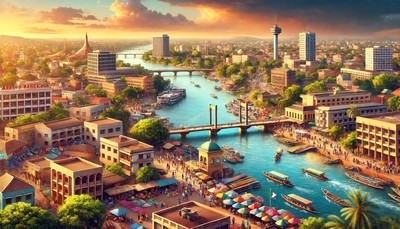
Day 2
Ségou
Ségou, located along the Niger River, is a historic and cultural gem in Mali. Known for its colonial architecture, vibrant arts scene, and relaxed riverside atmosphere, it offers a unique blend of history, nature, and local craftsmanship. Here are some top things to do in Ségou:
1. Walk Along the Niger River
Ségou’s location on the banks of the Niger River makes it one of the most scenic cities in Mali. A stroll along the river offers beautiful views, and you can watch fishermen, traditional pirogues (boats), and locals going about their daily lives.
2. Visit the Old Town of Ségou (Ségou-Koro)
A short trip from the modern city, Ségou-Koro is the original capital of the Bambara Kingdom. This ancient village features traditional mud-brick houses, the tomb of Biton Mamary Coulibaly (founder of the Bambara Empire), and a centuries-old mosque. It’s a fascinating place to learn about Mali’s pre-colonial history.
3. Explore the Ségou Artisan Market
Ségou is famous for its traditional arts and crafts. Visit the artisan market to see skilled craftsmen making bogolan (mud cloth), pottery, wood carvings, and leather goods. You can watch the artisans at work and buy authentic handmade souvenirs.
4. Experience the Ségou’ Art Festival (Festival sur le Niger)
If you visit in February, don’t miss the Festival sur le Niger, one of West Africa’s most important music and arts festivals. It features live performances from Malian and international artists, dance, theater, and art exhibitions—all set against the backdrop of the Niger River.
5. Discover Colonial-Era Architecture
Ségou was a major center during French colonial rule, and remnants of colonial architecture still stand today. Walk through the city’s wide boulevards and admire old colonial buildings, many of which have been preserved or repurposed.
6. Visit the Ndomo Bogolan Workshop
One of the best places to learn about bogolan (mud cloth), a traditional Malian textile, is the Ndomo Workshop. Here, artisans demonstrate how they dye fabrics using natural materials and traditional techniques. Visitors can even participate in workshops to create their own bogolan designs.
7. Take a Boat Trip on the Niger River
Hiring a pirogue (traditional wooden boat) for a river excursion is a great way to see Ségou from a different perspective. Some trips include visits to nearby fishing villages, where you can experience local river life.
8. Enjoy the Local Cuisine
Ségou offers some of the best traditional Malian food, including:
- Tiguadege Na (Peanut Sauce with Meat) – A popular dish served with rice.
- Capitaine Grillé (Grilled Nile Perch) – Fresh fish from the Niger River, often served with attiéké (cassava couscous).
- Dégue – A sweet yogurt and millet dessert.
9. Visit the Markala Dam
Located about 35 km from Ségou, the Markala Dam is an important hydroelectric and irrigation structure on the Niger River. It’s a peaceful place to visit and observe how the river is managed for agriculture and energy.
10. Explore Nearby Villages
For a deeper cultural experience, visit traditional villages around Ségou, such as:
- Kalabougou – Famous for its women-led pottery workshops, where traditional ceramic techniques are still used.
- Farako – A farming village where you can learn about millet and cotton cultivation.
Ségou is a laid-back city that offers an authentic Malian experience, rich in history, art, and culture. Whether you’re exploring ancient Bambara heritage, enjoying riverside views, or immersing yourself in local crafts, Ségou is a must-visit destination in Mali.
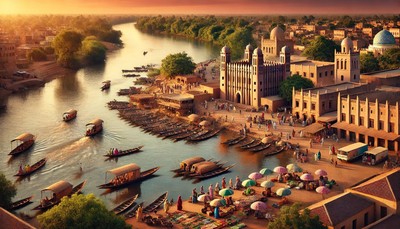
Day 3
Mopti
Mopti, often called the "Venice of Mali," is a lively port city located at the confluence of the Niger and Bani Rivers. It serves as a major trade and transportation hub and is a gateway to some of Mali’s most famous destinations, including Djenné and Dogon Country. Here are some of the best things to do in Mopti:
1. Explore the Mopti Grand Mosque
The Grand Mosque of Mopti is one of the city's most striking landmarks. Built in the Sudano-Sahelian style, similar to the famous mosque in Djenné, this mud-brick structure is a beautiful example of Malian architecture.
2. Take a Boat Trip on the Niger River
Mopti’s riverside location makes it one of the best places in Mali for a pirogue (wooden boat) tour. You can take a ride along the Niger River to see:
- Bozo fishing villages, where fishermen use traditional nets and techniques.
- Barge markets, where people trade goods directly from boats.
- Sunset cruises, which offer a stunning view of Mopti’s skyline.
3. Visit the Fishing Port and Market
Mopti’s bustling port and fish market are great places to experience local life. You can see Bozo and Somono fishermen unloading their daily catch, as well as women drying and smoking fish. The market is also a good place to try capitaine (Nile perch) or tilapia, fresh from the river.
4. Explore the Artisan Market
Mopti is known for its skilled artisans, and the Marché des Artisans (Artisan Market) is the best place to find locally made crafts. Look for:
- Bogolan (mud cloth) textiles
- Wood carvings
- Beaded jewelry
- Leather goods
It’s also a great place to watch craftsmen at work and learn about traditional Malian artistry.
5. Visit the Djenné Ferry Crossing
Mopti is the departure point for trips to Djenné, home to the famous Great Mosque of Djenné, a UNESCO World Heritage site. To get there, you'll take a ferry across the Bani River, which is an experience in itself—often packed with people, livestock, and goods.
6. Take a Day Trip to Dogon Country
Mopti is the main jumping-off point for treks into Dogon Country, one of Mali’s most fascinating cultural and archaeological regions. The journey takes you through traditional cliffside villages, sacred mask dances, and stunning landscapes.
7. Visit the Town’s Traditional Neighborhoods
Mopti is made up of several ethnic groups, each with its own distinct neighborhoods:
- Bozo Quarter – Home to the Bozo people, known for their fishing traditions.
- Tuareg Quarter – Where you can find Tuareg traders selling silver jewelry and leather goods.
- Somono Quarter – Famous for its traditional adobe houses.
8. Try Local Malian Cuisine
Mopti’s riverfront restaurants serve delicious local dishes. Some must-try foods include:
- Tô – A millet-based dish served with sauce.
- Mafé – A peanut-based stew with meat.
- Grilled Capitaine (Nile Perch) – Freshly caught from the Niger River.
9. Visit the Bani River Market
Mopti’s Bani River Market is a vibrant spot where traders from all over Mali come to sell goods, including textiles, spices, and livestock. It’s one of the best places to experience the city's lively atmosphere.
10. Explore Sévaré (Just Outside Mopti)
Sévaré, about 13 km from Mopti, is a quieter alternative for travelers looking for accommodation and security. It’s also home to several craft shops and cultural centers.
Final Thoughts
Mopti is a vibrant, culturally rich city that offers a true taste of Mali’s diverse traditions. Whether you're exploring its river markets, taking a boat ride, or using it as a base to visit Djenné and Dogon Country, Mopti is a must-visit destination for anyone traveling through Mali.
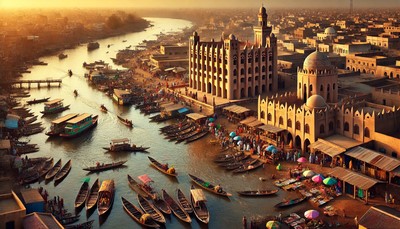
Day 4
Djenné
Djenné is one of Mali’s most iconic cities, famous for its stunning Sudano-Sahelian architecture, rich history, and vibrant culture. As a UNESCO World Heritage Site, it is one of the best places to experience traditional Malian life. Here’s what you shouldn’t miss when visiting Djenné:
1. Visit the Great Mosque of Djenné
The Great Mosque of Djenné is the largest mud-brick structure in the world and a masterpiece of Sudano-Sahelian architecture. Originally built in the 13th century and reconstructed in 1907, this mosque is the heart of the city.
- Non-Muslims are not allowed inside, but the exterior is breathtaking, especially during sunrise and sunset.
- If visiting in April, you may witness the annual replastering festival, where locals work together to restore the mosque’s mud walls.
2. Explore the Monday Market
Djenné’s Monday Market is one of the most famous markets in Mali. Held in the square in front of the Great Mosque, this bustling market is a must-see.
- Vendors from all over Mali and neighboring regions sell spices, fabrics, pottery, livestock, and fresh produce.
- The market is a fantastic place to experience local culture and interact with Bozo, Bambara, Fulani, and Tuareg traders.
3. Wander Through Djenné’s Old Town
Djenné’s streets are lined with traditional adobe houses, many of which are hundreds of years old. The town has remained largely unchanged for centuries, offering a glimpse into Mali’s architectural heritage.
- Walk through narrow alleyways to see the ornate facades of the mud-brick houses.
- Visit the Koranic schools, where children study in the same way they have for generations.
4. Visit the Djenné Archaeological Sites
Djenné is one of West Africa’s oldest cities, and its surroundings are filled with archaeological sites.
- Djenné-Djeno, about 3 km outside the modern city, is believed to be the oldest known city in sub-Saharan Africa, dating back to at least 250 BCE.
- Visit the site to see ancient artifacts and learn about the region’s pre-Islamic history.
5. Take a Pirogue Ride on the Bani River
Djenné is surrounded by the Bani River, and a pirogue (wooden boat) ride offers a peaceful way to see the town from a different perspective.
- Visit nearby Bozo fishing villages, where locals use traditional methods to catch fish.
- Watch the sunset over the river, with the silhouette of the Great Mosque in the background.
6. Explore the Local Artisan Workshops
Djenné is known for its skilled craftsmen and women. Visit local workshops to see:
- Bogolan (mud cloth) production
- Handmade pottery
- Wood carvings and leatherwork
Many of these artisans have been passing down their skills for generations, and you can purchase high-quality souvenirs directly from them.
7. Visit the Tomb of Tapama Djenepo
According to legend, Tapama Djenepo was a young girl sacrificed to ensure the prosperity of Djenné. Her tomb, located near the Great Mosque, is an important spiritual site where locals make offerings for protection and blessings.
8. Take a Day Trip to Fulani Villages
The Fulani (Peul) people are a major ethnic group in the region, known for their nomadic lifestyle and cattle herding.
- A short trip outside Djenné allows visitors to see traditional Fulani villages, where you can learn about their customs and daily life.
- It’s also a great opportunity to try fresh milk and local dairy products, which are central to Fulani cuisine.
9. Experience Djenné’s Spiritual and Educational Heritage
Djenné has long been a center of Islamic learning, and its madrassas (Koranic schools) continue to teach students from across West Africa.
- Visit one of these schools to see young students memorizing the Quran on wooden tablets.
- Some families host visitors for discussions on Islamic traditions in Mali.
10. Enjoy Traditional Malian Cuisine
Djenné’s small restaurants and street vendors serve authentic Malian food. Some must-try dishes include:
- Tiguadege Na – A peanut-based stew with meat.
- Jollof Rice – A flavorful rice dish with tomatoes, vegetables, and spices.
- Fresh grilled fish from the Bani River.
Final Thoughts
Djenné is one of Mali’s most magical and well-preserved historical cities. Whether you're admiring the Great Mosque, exploring ancient archaeological sites, or immersing yourself in the town’s vibrant market life, Djenné offers a unique cultural experience that takes you back in time.
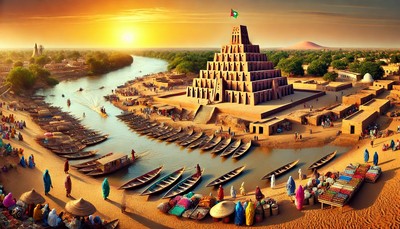
Day 5
Timbuktu
Timbuktu, the legendary "City of 333 Saints," was once a major center of Islamic scholarship, trade, and culture in West Africa. Though its golden age has faded, the city remains an important historical site with unique architecture, ancient manuscripts, and a mystical atmosphere. Here’s what to do in Timbuktu:
1. Visit the Ancient Mosques of Timbuktu
Timbuktu is home to three UNESCO-listed mosques, built in the Sudano-Sahelian architectural style, which played a crucial role in spreading Islam across West Africa.
- Djingareyber Mosque (built in 1327) – The most famous and largest of the three, constructed with mud bricks and wooden beams.
- Sankoré Mosque – Once part of the Sankoré University, one of the oldest Islamic learning centers in the world.
- Sidi Yahya Mosque – A smaller but historically significant mosque, known for its legends of a sealed door that remained closed for centuries.
These mosques are still in use today, and while non-Muslims may not be allowed inside, the exteriors are stunning examples of ancient West African architecture.
2. Explore the Timbuktu Manuscripts
Timbuktu was once a center of learning, attracting scholars from across Africa and the Middle East. Thousands of ancient Arabic and African manuscripts are still preserved today.
- Ahmed Baba Institute – A research center housing some of Timbuktu’s most valuable historical manuscripts.
- Mamma Haidara Library – One of the oldest private collections of Islamic manuscripts in Timbuktu.
These institutions protect centuries-old texts on astronomy, medicine, mathematics, and Islamic law. Some libraries allow visitors to view and learn about these precious historical documents.
3. Visit the Timbuktu Market
The Grand Marché (Main Market) of Timbuktu is a great place to experience the local culture.
- Browse through stalls selling Tuareg jewelry, leather goods, spices, and traditional fabrics.
- See Tuareg merchants wearing their iconic blue turbans, known as the tagelmust.
- Enjoy local street food like grilled meat skewers and millet-based dishes.
4. Explore the Maison de Tombouctou (House of Timbuktu)
This small but informative museum showcases the history of Timbuktu’s golden age, its scholars, traders, and explorers.
- Learn about the city’s role as a major stop on trans-Saharan trade routes.
- See historical artifacts, maps, and Tuareg cultural exhibits.
5. Visit the Explorers’ Monuments
Several European explorers attempted to reach Timbuktu during the 19th century, believing it to be a city of gold and wealth. The city honors some of them with monuments:
- René Caillié Monument – A tribute to the first European to reach Timbuktu (in 1828) and return alive.
- Gordon Laing Memorial – Honors the Scottish explorer who reached Timbuktu in 1826 but was killed before he could return.
These sites highlight Timbuktu’s once mysterious and mythical reputation in Europe.
6. Take a Camel Ride with the Tuareg Nomads
The Tuareg people, also known as the "Blue Men of the Desert," have long been traders and guides in the Sahara.
- Take a camel ride into the desert, just outside Timbuktu.
- Visit a Tuareg encampment to experience traditional tea ceremonies and music.
- Learn about nomadic life and desert survival techniques.
This experience gives you a glimpse into the ancient trans-Saharan trade routes, where caravans once transported salt, gold, and manuscripts across the Sahara.
7. Visit the Flamme de la Paix (Flame of Peace)
This monument commemorates the 1996 peace agreement between the Malian government and Tuareg rebels.
- It symbolizes the end of conflicts in the region.
- Weapons collected from fighters were burned to mark the beginning of a peaceful era.
It’s a meaningful site that reflects Timbuktu’s complex history of conflict and resilience.
8. Discover the Ancient Salt Trade at the Azalai Market
Salt was once as valuable as gold, and Timbuktu played a key role in the trans-Saharan salt trade.
- Visit the Azalai Market, where slabs of salt from the Taoudenni salt mines (deep in the Sahara) are still traded today.
- Watch caravans of camels arriving with heavy salt blocks, continuing a centuries-old tradition.
This market offers a glimpse into Timbuktu’s past as a major trading hub.
9. Take a Boat Ride on the Niger River
Though Timbuktu is on the edge of the Sahara, the Niger River flows nearby.
- Take a pirogue (wooden boat) ride to visit Bozo fishing villages.
- Enjoy a sunset cruise to see the desert skyline against the river.
The river is a vital lifeline for Timbuktu and its people, connecting it to cities like Mopti and Djenné.
10. Try Local Malian Cuisine
Timbuktu has a mix of Malian, Tuareg, and Saharan influences in its cuisine. Some must-try dishes include:
- Taguella – A Tuareg flatbread, cooked under the sand and eaten with meat sauce.
- Tô – A millet-based dish, served with okra sauce.
- Grilled Camel Meat – A delicacy in the region.
- Sweet Tuareg Tea – A strong green tea, served in three rounds (each cup getting progressively sweeter).
Food is an essential part of Timbuktu’s cultural experience.
Final Thoughts
Timbuktu remains a mystical and historic city, rich in Islamic scholarship, trans-Saharan trade history, and Tuareg culture. Whether you’re exploring its ancient mosques, riding a camel in the desert, or learning about centuries-old manuscripts, Timbuktu offers an unforgettable glimpse into Mali’s golden age and the legacy of West Africa’s intellectual and trade empires.
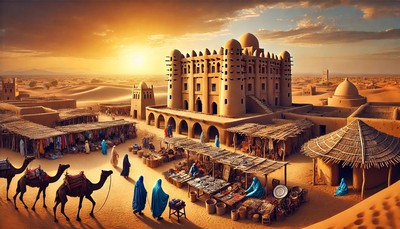
Day 6
Gao
Gao, located along the Niger River in eastern Mali, was once the capital of the Songhai Empire and a major trading hub in West Africa. Today, it remains an important cultural and historical city with fascinating monuments, traditional markets, and beautiful desert landscapes. Here’s what to do in Gao:
1. Visit the Tomb of Askia (UNESCO World Heritage Site)
The Tomb of Askia, built in the 15th century by Askia Mohamed, the first emperor of the Songhai Empire, is one of the most iconic sites in Gao.
- The pyramid-shaped mud-brick structure reflects the Sudano-Sahelian architectural style.
- It is believed to be the burial place of Askia Mohamed, one of West Africa’s greatest rulers.
- Visitors can admire the mosque and minaret, which are still used today for prayers.
This site is a UNESCO World Heritage Site and one of the best-preserved remnants of the Songhai Empire.
2. Explore the Gao Market
Gao’s Grand Marché (Main Market) is a bustling place where locals trade everything from fresh produce, spices, and fabrics to handmade crafts.
- Look for Tuareg silver jewelry, traditional leatherwork, and woven baskets.
- Taste local dishes like grilled fish from the Niger River and rice-based meals.
- Experience the diverse ethnic groups, including Songhai, Tuareg, Fulani, and Bozo merchants.
3. Take a Boat Ride on the Niger River
The Niger River runs through Gao, offering great opportunities for boat trips and scenic views.
- Take a pirogue (wooden boat) ride to explore nearby Bozo fishing villages.
- Enjoy a sunset cruise for stunning views of the river and desert.
- Visit river islands where nomadic herders bring their animals to drink.
The river is central to life in Gao, and a boat ride offers a peaceful way to experience the region.
4. See the Dunes Roses (Pink Dunes)
Just outside Gao, the Dunes Roses (Pink Dunes) are one of the most beautiful natural sites in the area.
- The dunes change color depending on the time of day, turning pinkish-orange at sunrise and sunset.
- Climb to the top for a panoramic view of the Niger River and surrounding desert.
- This is a great spot for camel rides and desert photography.
Locals consider the dunes a sacred place, and they are a popular gathering spot for evening relaxation.
5. Visit the House of the Tuareg (Maison des Touaregs)
The Tuareg people, known as the "Blue Men of the Desert," have a long history in Gao.
- This center showcases Tuareg crafts, traditional clothing, and artifacts.
- Learn about their nomadic way of life, music, and tea ceremonies.
- Buy handmade Tuareg silver jewelry and leather goods as souvenirs.
6. Explore the Historic Koukia Ruins
Koukia, located near Gao, is believed to be an early settlement of the Songhai people before they established their empire.
- The ruins include ancient foundations and burial sites.
- Some historians believe it was one of the earliest West African trading centers along the Niger River.
It’s a less-visited site, but it provides a glimpse into the region’s pre-colonial history.
7. Discover the Askia Palace Ruins
Near the Tomb of Askia, some remnants of Askia Mohamed’s former palace can still be seen.
- These ruins are a reminder of Gao’s golden age during the Songhai Empire.
- Though much has been lost, local guides can share stories of the empire’s past glory.
8. Visit the Gao Mosque (Mosquée de Gao)
Gao’s main mosque is an important religious site.
- It is built in a style similar to Timbuktu’s mosques, with mud-brick walls and wooden support beams.
- The mosque remains an active place of worship and a significant cultural landmark.
9. Take a Desert Excursion to Bourem
Bourem, a small town north of Gao, offers an even deeper experience of the Saharan desert landscape.
- Take a 4x4 drive or camel trek to explore Tuareg camps and nomadic settlements.
- Witness the traditional salt trade, which has existed for centuries in the region.
- Visit seasonal oasis areas where herders bring their livestock.
This trip gives visitors a closer look at traditional desert life.
10. Try Local Songhai Cuisine
Gao offers a mix of Songhai, Tuareg, and Bozo culinary traditions. Some must-try dishes include:
- Capitaine Grillé – Grilled Nile perch from the Niger River.
- Tô – A millet-based dish served with a thick sauce.
- Mafé – A peanut-based stew with meat and vegetables.
- Sweet Tuareg Tea – A traditional three-step tea ceremony, symbolizing hospitality.
Final Thoughts
Gao is a city full of history, desert beauty, and cultural richness. Whether you’re exploring ancient tombs, sailing the Niger River, or riding camels on pink dunes, Gao offers an authentic experience of Mali’s past and present.
